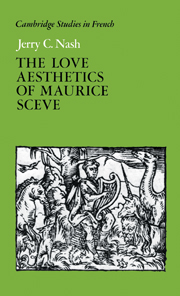Book contents
- Frontmatter
- Contents
- Preface
- 1 The problem of the dark side of a love poet: an introduction and reassessment
- 2 In search of love's epistemology: affirming the role of the creative imagination
- 3 Embodying the sacred and ineffable: poetic forms of transcendence and paradise
- 4 Becoming what one sees: the unity and identity of poetic self
- 5 Struggle, light, and love's “sainct lieu”
- 6 “De mes trauaulx me bienheurantz ma peine”: love poetry as therapy
- Epilogue Scève, Mallarmé, and the art of transcendence
- Notes
- Bibliography
- Index
- Cambridge Studies in French
Epilogue Scève, Mallarmé, and the art of transcendence
Published online by Cambridge University Press: 22 August 2009
- Frontmatter
- Contents
- Preface
- 1 The problem of the dark side of a love poet: an introduction and reassessment
- 2 In search of love's epistemology: affirming the role of the creative imagination
- 3 Embodying the sacred and ineffable: poetic forms of transcendence and paradise
- 4 Becoming what one sees: the unity and identity of poetic self
- 5 Struggle, light, and love's “sainct lieu”
- 6 “De mes trauaulx me bienheurantz ma peine”: love poetry as therapy
- Epilogue Scève, Mallarmé, and the art of transcendence
- Notes
- Bibliography
- Index
- Cambridge Studies in French
Summary
Throughout the chapters of this book, I have been suggesting that there exists a very real aesthetic connection between Scève and Mallarmé. A more precise analysis of this literary affinity shall serve as a fitting conclusion to this book. What Valéry saw in Mallarmé's magical power of poetic incantation can be seen in Scève. We now know the formula by which Valéry defined it. His definition of Art and its supreme principle of spiritually transfigured objects applies to Scève and his love words. Délie as the beloved, sensuous object (Valéry's “forme sensible” providing a “séduction immédiate”) becomes the paradisally portrayed image (Valéry's “idée” or “substance précieuse de pensée”) through which the sacred is apprehended, just like Délie as love text is the poetic medium through which the poet communicates to us the same ineffable experience of combining emotive form with higher meaning. What is intriguing in Scève, and can be very revealing and helpful in reading him, is the degree to which he anticipates our more modern symbolist concern with sacralizing the secular. The constant use to which he puts poetry is not simply as a means of recording and relating experience, as other Renaissance poets seem to use it, but as a continuous series of creative acts intent on revelation, as the epistemological means of truly discovering and creating experience.
- Type
- Chapter
- Information
- The Love Aesthetics of Maurice ScèvePoetry and Struggle, pp. 150 - 165Publisher: Cambridge University PressPrint publication year: 1991



